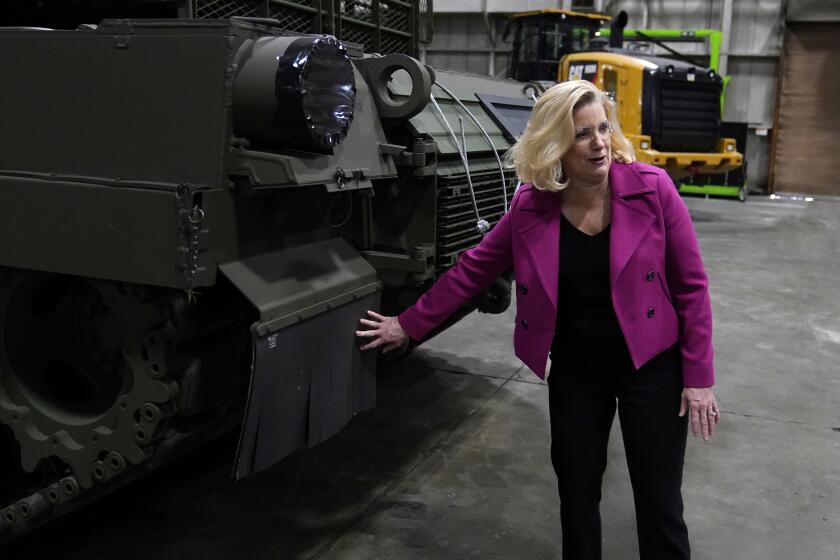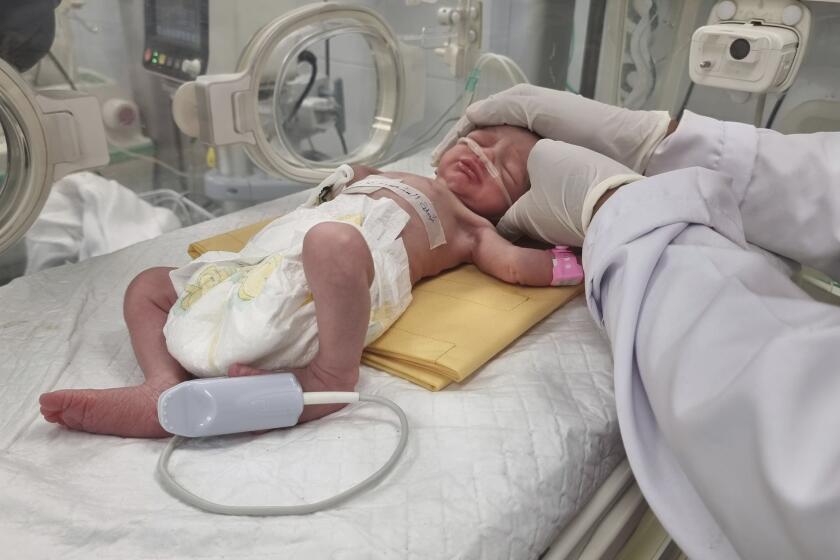A Hotbed of SARS Warfare
At Singapore Changi Airport, passengers walk past a thermal-imaging scanner that instantly shows whether any of them has a fever.
All over the city, taxi drivers, government workers, waitresses, bank tellers and bellboys take their temperatures at least once a day. So do visitors to government buildings, reporters going to news conferences and women arriving at the beauty parlor.
Many residents proudly wear the country’s new badge of honor: a sticker showing they are fever-free.
It is a brave new world here in Singapore, where government-ordered mass temperature testing has become one of the most important measures in preventing the spread of severe acute respiratory syndrome.
The autocratic city-state, which has suffered 27 deaths and huge economic losses from the disease, has moved aggressively to contain the pneumonia-like virus and restore public confidence. So far, the effort appears to be working.
“The government in Singapore can control anything,” said cabdriver Tan Boon Hoe, displaying a pile of company-issued stickers that show his temperature has been normal for 10 days.
Checking for fevers is one of the least intrusive measures. The government has quarantined more than 3,100 Singaporeans in their homes for 10-day periods, installing Web cams -- cameras connected to the Internet -- in those residences to monitor people once or twice a day. Those caught flouting the quarantine must wear electronic bracelets that signal their movements. Soldiers and police detectives help track down people who may have come in contact with SARS patients.
Doctors have concluded that fever is the most obvious sign of SARS’ onset. To detect cases early, the government is setting up high-tech temperature scanners at all entry points to the country, and it aims to distribute digital thermometers to every schoolchild and household. Officials hope that nearly everyone’s temperature in the country of 4 million will be monitored daily by midmonth. The fever checks could continue indefinitely.
“Our social behavior will change in the sense that we will all take our temperature twice a day,” said Dr. Balaji Sadasivan, minister of state for health and the environment, “and instead of talking about the weather we will ask, ‘What’s your temperature today?’ ”
If SARS persists in pockets around the world, Singapore officials predict that temperature screening at airports will become as commonplace as X-raying baggage for bombs.
The disease has created one of Singapore’s worst crises in its nearly 38 years of independence. The wealthy city-state has reported 204 probable SARS cases -- third in number behind China, where the disease originated, and Hong Kong.
Singapore is one of Southeast Asia’s most important financial centers and a transportation hub. About 1,300 U.S. companies operate here, and the economy depends on business travelers and tourists.
The government estimates that SARS could cost Singapore $860 million and cut its economic growth by half this year. The number of visitors in late April was 71% less than a year earlier. Singapore Airlines has slashed a fifth of its flights. In many hotels, occupancy has plummeted to 20%. Unemployment went up slightly in March and is expected to rise further. The government has pledged $135 million to help hotels and airlines and is paying some quarantined workers a daily stipend of $40.
Far beyond most cities, Singapore is noted for its cleanliness and order. It is also known for an overbearing form of government that some call “the nanny state.” Singapore is famous for banning chewing gum and ordering its citizens to flush public toilets. Individual liberty is second to the greater good. The government has the power to lock up opponents without trial.
In combating SARS, Singapore did not hesitate to impose draconian measures.
“It’s a time when a benevolent dictatorship can take action more quickly than a Western democracy,” Singapore resident Lawrence Harding said after passing through the airport temperature scanner. “People listen to what the government says and do what they’re told.”
Some Singaporeans have complained about the strict quarantine measures, but most are reassured by the government’s tough response. During the worst weeks, many people stopped going to restaurants and malls, but the temperature checks are helping to bring back confidence and customers.
Singapore’s problems began when Esther Mok, a 23-year-old former airline flight attendant, went on a shopping trip to Hong Kong in February.
In Hong Kong, she stayed at the Metropole Hotel on the same floor as a doctor who had recently arrived from southern China. The doctor was highly contagious and apparently spread SARS by coughing or sneezing. He gave it to Mok and at least five other guests, including travelers who carried the bug to Toronto and Hanoi, causing outbreaks there.
On her return to Singapore, Mok became a modern-day Typhoid Mary. Soon after, she was hospitalized with a fever and respiratory problems. SARS had ravaged southern China since November, but at that point, the Chinese government had revealed little about the virus. For a week, Singapore doctors were in the dark and Mok spread the disease to 20 other people.
Among them were her parents, her 73-year-old grandmother, her uncle and her pastor, health officials say. All of them died, except her grandmother. Mok also gave the virus to a nurse who had helped care for her. The nurse passed it on to others, including a woman who was in the intensive-care unit with a heart ailment. Before the heart patient died, she gave the virus to 25 more people, including a man who had been admitted for an ulcer. He was transferred to another hospital before doctors realized he had SARS.
At the second hospital, the ulcer patient gave the disease to 35 others, including his brother, officials say. The brother then spread it to the city’s wholesale vegetable market.
Doctors say that all but six of the island’s probable cases can be traced to Mok. The other carriers arrived from abroad with the illness but apparently have not passed it on. Mok has recovered but remains in the hospital, trying to cope with her grief and avoid the hostility of Singaporeans initially angry with her for spreading the virus.
“People are finally realizing there is no one to blame, least of all Esther,” said Dr. Lim Suet Wun, chief executive of Tan Tock Seng Hospital, which is handling all the city-state’s SARS cases. “She did what every Singaporean does, travel and shop. That’s no crime. She came to a hospital. That’s no crime. It’s really a misfortune she happened to be the person.”
In the early stages of the disease, nearly all of Singapore’s victims contracted the virus in hospitals. Like the New York firefighters who entered the World Trade Center’s twin towers on Sept. 11, 2001, Singapore’s health care workers who treated the first SARS patients have become local heroes. “The people in the early days who went into wards were extremely courageous,” said Lim. “The risk and the lack of knowledge at that point were astounding.”
Unlike some places where SARS has struck, Singapore was quick to act once doctors understood the nature of the disease.
Tan Tock Seng was designated to care for SARS patients. Special ambulances were assigned to pick up suspected cases. After the ulcer patient’s transfer, moving any patients or doctors between hospitals was prohibited, except to bring SARS cases to Tan Tock Seng. Finally, visitors were banned from all hospitals.
The government closed schools and the Pasir Panjang vegetable market for weeks. Health workers, police detectives and soldiers have attempted to trace every person who had come in contact with a SARS patient and ordered into quarantine anyone who might have been exposed to the virus.
Officials say they call quarantined homes at random intervals -- sometimes in the middle of the night -- asking residents to turn on government-installed Web cameras and show themselves. Those who aren’t home -- or who don’t answer the phone -- are ordered to wear electronic bracelets so authorities can track their movements. One repeat offender went out drinking in bars and boasted to coffee shop customers that he had broken quarantine. He was arrested and faces six months in jail.
At the same time, the government has flooded the public with information. Top officials have held news conferences almost daily. The Straits Times, the country’s main newspaper, runs dozens of SARS stories daily.
Singapore’s strict measures seem to have satisfied the World Health Organization. The agency has warned travelers to avoid Beijing, southern China, Hong Kong and, for a time, Toronto, but it never advised against travel to Singapore. On Tuesday, the U.S. Centers for Disease Control and Prevention removed Singapore from its list of countries that travelers should avoid.
Today, this island nation appears to be bringing the disease under control. Five new probable cases have been reported since April 28, and no new infections of health-care workers have been reported since April 17. A total of 1,015 people remain quarantined. If no new cases arise by the end of next week, officials will declare the virus contained.
To detect any remaining cases and guard against the arrival of new ones, the government is placing a high priority on the temperature screening effort. Nurses armed with ear thermometers are stationed at the entrances of hospitals, government ministries and other public buildings to check for fevers among workers and visitors. Those found to have high temperatures are examined and, in some cases, sent to the hospital.
The thermal scanners, which were developed by Singapore’s defense industry, are in short supply. Currently, only passengers arriving at Singapore’s airport from SARS-affected areas and all departing passengers are scanned. Monitors will soon be in place to check every passenger who arrives, departs or changes planes. Scanners also are being set up to check those arriving in Singapore by car or boat.
The scanner is an infrared camera that senses a subject’s temperature and displays his or her image on a monitor. If the person’s temperature is below 99.5 degrees, the face on the monitor will appear green. If it is at or above 99.5, the face will appear red. Since the scanners went into service on April 11, 964 people have been stopped for running a fever. Thirty were sent to the hospital, but only one has been identified as a suspected SARS case and is being held for observation.
After weeks of anxiety over SARS, passengers seem to welcome the scanners. “I think it’s a very good idea,” said Veronica Diermayr, an Austrian research scientist and Singapore resident who was traveling to Indonesia. “I think they ought to set it up everywhere. It brings back confidence. Everyone can be sure that this area is fever-free.”
More to Read
Start your day right
Sign up for Essential California for news, features and recommendations from the L.A. Times and beyond in your inbox six days a week.
You may occasionally receive promotional content from the Los Angeles Times.





